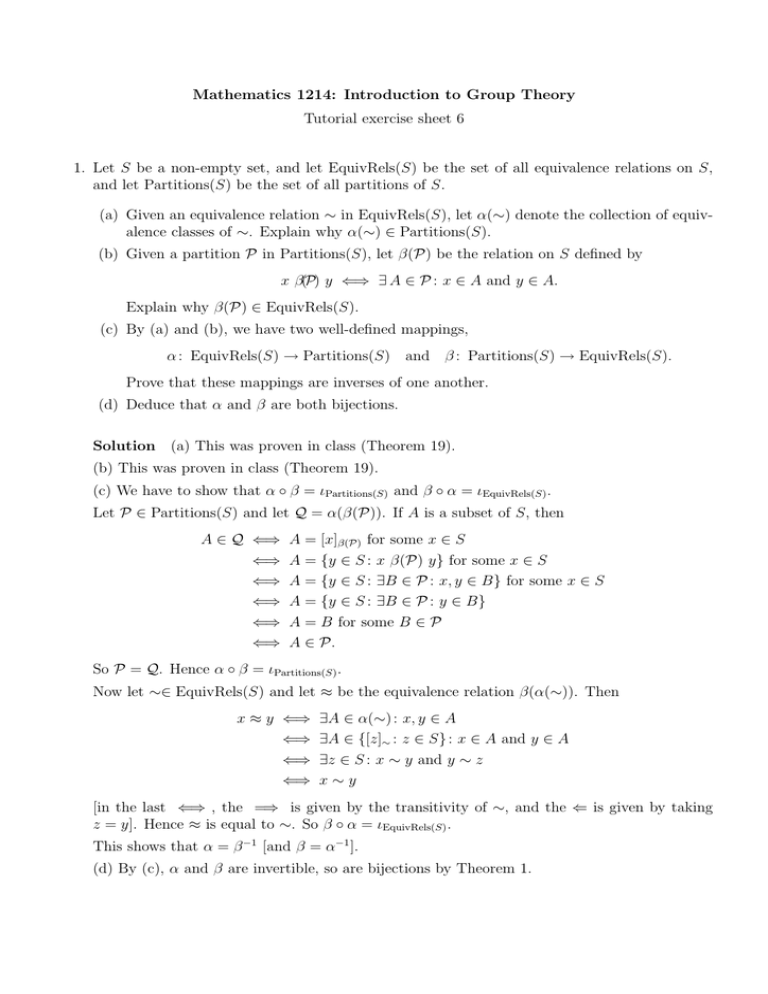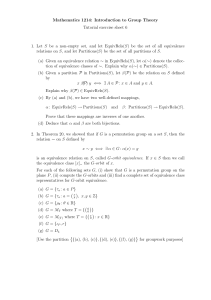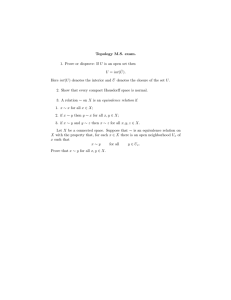Mathematics 1214: Introduction to Group Theory Tutorial exercise sheet 6
advertisement

Mathematics 1214: Introduction to Group Theory
Tutorial exercise sheet 6
1. Let S be a non-empty set, and let EquivRels(S) be the set of all equivalence relations on S,
and let Partitions(S) be the set of all partitions of S.
(a) Given an equivalence relation ∼ in EquivRels(S), let α(∼) denote the collection of equivalence classes of ∼. Explain why α(∼) ∈ Partitions(S).
(b) Given a partition P in Partitions(S), let β(P) be the relation on S defined by
x β(P) y ⇐⇒ ∃ A ∈ P : x ∈ A and y ∈ A.
Explain why β(P) ∈ EquivRels(S).
(c) By (a) and (b), we have two well-defined mappings,
α : EquivRels(S) → Partitions(S) and β : Partitions(S) → EquivRels(S).
Prove that these mappings are inverses of one another.
(d) Deduce that α and β are both bijections.
Solution (a) This was proven in class (Theorem 19).
(b) This was proven in class (Theorem 19).
(c) We have to show that α ◦ β = ιPartitions(S) and β ◦ α = ιEquivRels(S) .
Let P ∈ Partitions(S) and let Q = α(β(P)). If A is a subset of S, then
A ∈ Q ⇐⇒
⇐⇒
⇐⇒
⇐⇒
⇐⇒
⇐⇒
A = [x]β(P) for some x ∈ S
A = {y ∈ S : x β(P) y} for some x ∈ S
A = {y ∈ S : ∃B ∈ P : x, y ∈ B} for some x ∈ S
A = {y ∈ S : ∃B ∈ P : y ∈ B}
A = B for some B ∈ P
A ∈ P.
So P = Q. Hence α ◦ β = ιPartitions(S) .
Now let ∼∈ EquivRels(S) and let ≈ be the equivalence relation β(α(∼)). Then
x ≈ y ⇐⇒
⇐⇒
⇐⇒
⇐⇒
∃A ∈ α(∼) : x, y ∈ A
∃A ∈ {[z]∼ : z ∈ S} : x ∈ A and y ∈ A
∃z ∈ S : x ∼ y and y ∼ z
x∼y
[in the last ⇐⇒ , the =⇒ is given by the transitivity of ∼, and the ⇐ is given by taking
z = y]. Hence ≈ is equal to ∼. So β ◦ α = ιEquivRels(S) .
This shows that α = β −1 [and β = α−1 ].
(d) By (c), α and β are invertible, so are bijections by Theorem 1.
2. In Theorem 20, we showed that if G is a permutation group on a set S, then the relation ∼
on S defined by
x ∼ y ⇐⇒ ∃ α ∈ G : α(x) = y
is an equivalence relation on S, called G-orbit equivalence. If x ∈ S then we call the equivalence
class [x]∼ the G-orbit of x.
For each of the following sets G, (i) show that G is a permutation group on the plane P ,
(ii) compute the G-orbits and (iii) find a complete set of equivalence class representatives for
G-orbit equivalence.
(a) G = {τa : a ∈ P }
(b) G = {τa : a =
x
y
, x, y ∈ Z}
(c) G = {ρθ : θ ∈ R}
(d) G = MT where T = {
(e) G = M(T ) where T = {
0
0
}
x
0
: x ∈ R}
(f) G = {ιP , r}
(g) G = D4
[Use the partition {(a), (b), (c)}, {(d), (e)}, {(f), (g)} for groupwork purposes]
Solution (a) We have G ⊆ M ⊆ Sym(P ), ιP = τ0 ∈ G and for a, b ∈ P we have τa ◦ τb−1 =
τa−b ∈ G. Hence G is a subgroup of (Sym(P ), ◦). For any a ∈ P we have a = τa (0), so
a ∼ 0. So [0] = P and the collection of G-orbits is {P }, and a complete set of equivalence class
representatives is {0}.
x
(b) We have G ⊆ Sym(P
),
ι
=
τ
∈
G
and
for
a,
b
∈
{
: x, y ∈ Z} we have τa ◦ τb−1 = τc
y
P
0
where c = a − b ∈ { xy : x, y ∈ Z}, so τa ◦ τb−1 ∈ G. So G ≤ (M, ◦). For any p, q ∈ P we have
p ∼ q ⇐⇒ ∃x, y ∈ Z : p = τ x (q) = q + xy ,
y
so the equivalence classes are the sets [q] = {q + xy : x, y ∈ Z} for q ∈ P . A complete
set of
s
S
equivalence
class
representatives is R = { t : 0 ≤ s, t < 1}. Indeed, for any p = T ∈ P we
s
S
have T ∼ t where s is the fractional part of S (the largest integer less than
or equal to S)
and t is the fractionalpart of T , and if 0 ≤ s1 , s2 , t1 , t2 < 1 then st11 − st22 does not have
integer entries, so st11 6∼ st22 . Hence each equivalence class contains precisely one element
of R.
(c) Since ρθ ◦ ρ−1
φ = ρθ−φ , it’s easy to check that G ≤ (Sym(P ), ◦), so G is a permutation
group. Also, the G-orbit of p 6= 0 is the set of points obtained by rotating p through all
possible angles about the origin, giving the circle centred at the origin passing through p, and
we also have [0] = {0}. So these
are the equivalence classes, and a complete set of equivalence
x
class representatives is { 0 : x ≥ 0} (since this set contains exactly one element from each
equivalence class).
(d) G is a permutation group by Theorem 13 and Theorem 16. We have α ∈ GT ⇐⇒ α(0) =
0 ⇐⇒ α = ρθ or α = ρθ ◦ r for some θ ∈ R. The orbit of 0 under this group is [0] = {0},
2
and if p ∈ P with p 6= 0 then the orbit of p ∈ P under this group is the circle centred at 0
through p. So the equivalence classes are the same as in c.
(e) G is a permutation group by Theorem 15 and Theorem 16. We have α ∈ G ⇐⇒ α(0) ∈
T and α(e1 ) ∈ T and α(T ) = T ⇐⇒ α = τa or α = τa ◦ r where a = x0 for some x ∈ R.
[Here we have used Theorem 18 and the conditions α(0) ∈ T and α(e1 ) ∈ T to narrow down
the possibilities (forcing θ = 0 and a to be of the stated form), and then we check that all of
these possibilities are, indeed, in G].
Now if p ∈ P then the G-orbit of p is [p] = {τa (p), τa (r(p)) : a = x0 , x ∈ R} consists of the
union of the horizontal line passing through p and the horizontal line passing through r(p) [or,
if p is on the x-axis then these two lines are both
the x-axis, and [p] is x-axis.] So a complete
set of equivalence class representatives is { y0 : y ≥ 0}.
(f) It’s easy
to check that G is a group under composition, so it is a permutation group. Let
x
T = { 0 : x ∈ R} be the x-axis. If p ∈ T then [p] = {ι(p), r(p)} = {p, p} = {p}, and if
p ∈ P and p 6∈ T then [p] = {p, r(p)}. So a complete set of equivalence class representatives is
{ xy : x ∈ R, y ≥ 0}, since this set contains exactly one element from each equivalence class.
(g) (D4 , ◦) is a group of permutations of P , so it’s a permutation group. Now
D4 = {ι, ρ, ρ2 , ρ3 , r0 , r1 , r2 , r3 }
where ι = ιP and ρ = ρπ/2 and rj = ρj ◦ r for j = 0, 1,2, 3. Hence if p ∈ P then [p] =
{p, ρ(p), ρ2 (p), ρ3 (p), r0 (p), r1 (p), r2 (p), r3 (p)}. Let E = { xy : 0 ≤ y ≤ x}. We claim that E is
a complete set of equivalence class representatives for ∼. Indeed, by drawing a picture, we see
that no two elements of E are G-orbit equivalent, so each equivalence class contains at most
one element of E. Now let F = E ∪ r(E). Then F ∪ ρ(F ) ∪ ρ2 (F ) ∪ ρ3 (F ) = P , so every element
of P is equivalent to some element of E. This shows that every equivalence class contains at
least one element of E. Hence every equivalence class contains exactly one element of E, so E
is a complete set of equivalence class representatives for ∼.
3


![MA1124 Assignment3 [due Monday 2 February, 2015]](http://s2.studylib.net/store/data/010730345_1-77978f6f6a108f3caa941354ea8099bb-300x300.png)





